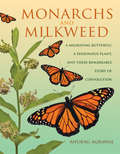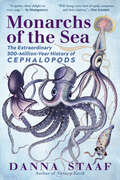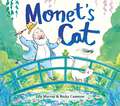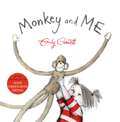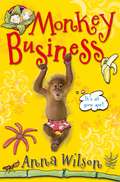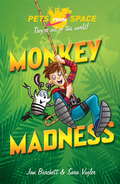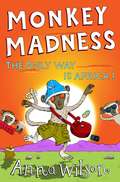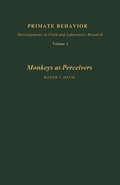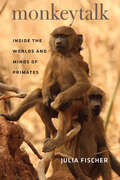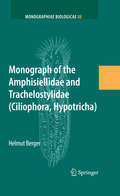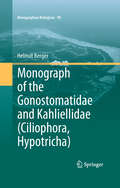- Table View
- List View
Monarchs and Milkweed: A Migrating Butterfly, a Poisonous Plant, and Their Remarkable Story of Coevolution
by Anurag AgrawalThe fascinating and complex evolutionary relationship of the monarch butterfly and the milkweed plantMonarch butterflies are one of nature's most recognizable creatures, known for their bright colors and epic annual migration from the United States and Canada to Mexico. Yet there is much more to the monarch than its distinctive presence and mythic journeying. In Monarchs and Milkweed, Anurag Agrawal presents a vivid investigation into how the monarch butterfly has evolved closely alongside the milkweed—a toxic plant named for the sticky white substance emitted when its leaves are damaged—and how this inextricable and intimate relationship has been like an arms race over the millennia, a battle of exploitation and defense between two fascinating species.The monarch life cycle begins each spring when it deposits eggs on milkweed leaves. But this dependency of monarchs on milkweeds as food is not reciprocated, and milkweeds do all they can to poison or thwart the young monarchs. Agrawal delves into major scientific discoveries, including his own pioneering research, and traces how plant poisons have not only shaped monarch-milkweed interactions but have also been culturally important for centuries. Agrawal presents current ideas regarding the recent decline in monarch populations, including habitat destruction, increased winter storms, and lack of milkweed—the last one a theory that the author rejects. He evaluates the current sustainability of monarchs and reveals a novel explanation for their plummeting numbers.Lavishly illustrated with more than eighty color photos and images, Monarchs and Milkweed takes readers on an unforgettable exploration of one of nature's most important and sophisticated evolutionary relationships.
Monarchs of the Sea: The Extraordinary 500-Million-Year History of Cephalopods
by Danna StaafAn epic evolutionary history of cephalopods: from the ancient mollusks that invented swimming five hundred million years ago, to the octopuses, squid, and other inscrutably intelligent animals of today
Monet's Cat
by Lily Murray Becky CameronMonet’s Cat tells the story of a magical pottery cat, Chika, who comes alive to explore Monet’s paintings from within. Join her as she visits four famous works of art – causing chaos at a picturesque picnic lunch, getting lost in the smog at a train station, running riot at the beach and making a splash at the water lily pond. But can her famous owner keep up with her exploits? Featuring beautiful illustrations inspired by Monet’s paintings, as well as gallery pages showcasing reproductions of his work, this charming story encourages even the youngest children to engage with, explore and enjoy Monet’s art.
Monitoring and Intervention for the Critically Ill Small Animal: The Rule of 20
by Rebecca Kirby Andrew LinklaterMonitoring and Intervention for the Critically Ill Small Animal: The Rule of 20 offers guidance for assessing the patient, interpreting diagnostic test results, and selecting appropriate monitoring procedures. Based on Rebecca Kirby’s time-tested Rule of 20, with a chapter devoted to each item on the checklist Provides comprehensive guidance for monitoring a critically ill small animal patient Emphasizes the interplay of each parameter with one another Designed for fast access on the clinic floor, with potentially life-saving ideas, tips, lists and procedures Presents tables, schematics, algorithms, and drawings for quick reference
Monitoring and Intervention for the Critically Ill Small Animal: The Rule of 20
by Rebecca Kirby Andrew LinklaterMonitoring and Intervention for the Critically Ill Small Animal: The Rule of 20 offers guidance for assessing the patient, interpreting diagnostic test results, and selecting appropriate monitoring procedures. Based on Rebecca Kirby’s time-tested Rule of 20, with a chapter devoted to each item on the checklist Provides comprehensive guidance for monitoring a critically ill small animal patient Emphasizes the interplay of each parameter with one another Designed for fast access on the clinic floor, with potentially life-saving ideas, tips, lists and procedures Presents tables, schematics, algorithms, and drawings for quick reference
Monitoring Nature Conservation in Cultural Habitats: A Practical Guide and Case Studies
by Clive Hurford Michael SchneiderThis is the first book to present monitoring as an integral component of responsible conservation management and as a catalyst for decision making. The early sections of this illustrated book cover key areas in the development of a monitoring project. The later sections of the book comprise a series of case studies covering a wide range of habitats and species. These case studies focus mostly, though not exclusively, on sites that form part of the Natura 2000 series in Europe.
Monitoring Plant and Animal Populations: A Handbook for Field Biologists
by Caryl L. Elzinga Daniel W. Salzer John W. Willoughby James P. GibbsMonitoring Plant and Animal Populations offers an overview of population monitoring issues that is accessible to the typical field biologist and land managers with a modest statistical background. The text includes concrete guidelines for ecologists to follow to design a statistically defensible monitoring program. User-friendly, practical guide, written in a highly readable format. The authors provide an interdisciplinary scope to address the current, widespread interest in monitoring in many environmental fields, including pure and applied ecology, conservation biology, and wildlife management. Emphasizes the role of monitoring in adaptive management. Defines important terminology and contrasts monitoring with other data-collection activities. Covers the applicable principles of sampling and shows how to design a monitoring project. Provides a step-by-step overview of the monitoring process, illustrated by flow charts and references. The authors also offer guidelines for analyzing and interpreting monitoring data. Illustrates the foundation of management objectives and describes their components, types, and development. Describes common field techniques for measuring important attributes of animal and plant populations. Reviews different methods for recording monitoring data in the field, managing the data, and communicating data to policy makers.
Monkey and Me
by Emily GravettMonkey and Me by Emily Gravett, twice winner of the Kate Greenaway Medal, is a beautifully illustrated story full of animal fun!A mischievous little girl and her toy monkey swing irresistibly through the pages of this playful book. Young children will love guessing what animal they are pretending to be, before shouting out the answers as the pages are turned to reveal the real creatures. Soon everyone will be waddling like a penguin, jumping like a kangaroo and waving their arm like an elephant's trunk!
Monkey Bedtime
by Alex EnglishSuddenly I heard an EEK, a TAP TAP on the pane.A tiny little monkey face was peering through the rain.I'm sure my mom won't mind, I thought. He's really very small.One tiny pygmy marmoset could do no harm at all. . .When a little boy lets a monkey in through his window, he doesn't expect it to bring all its friends!But when he is followed by six red-handed howlers, six macaques, ten capuchins and two great big baboons there's going to be trouble! Surely mum will notice the banana skins, the toothpaste, the handprints on the walls . . .Will he ever get to bed with all this monkeying around?Alex's hilarious rhyming text matched with Pauline's expressive illustrations makes for the perfect bedtime read!
Monkey Business
by Anna WilsonFor Felix and Flo, animals are the NUMBER ONE TOP PRIORITY in life. And although Felix loves his pets (a lazy dog, an angry cat and a noisy hamster), what he really wants is the chance to look after an animal which is EXOTIC and DIFFERENT – like an elephant, or a monkey, for instance. So when he finds out from Flo that you can actually adopt your own animal via the MIRACLE OF THE INTERNET, he is beside himself with excitement – until he realises that this plan isn’t as FOOLPROOF as it seems…
Monkey (Large Print)
by RnibThis is an image of a monkey, standing with its face and body forward. There is a locator dot shown, which will be at the top left of the page when the image is the right way up. At the top centre of the page is the monkey's arm with its hand outstretched. Further down, in the centre of the page, is the monkey's head with two eyes, a nose, a mouth, and ears to either side. Down the page is its body and to the left of this is its other arm with fingers pointing to the right. To the right of its body is the monkey's tail. Down from this are the monkey's two legs with finger-like toes.
Monkey Madness: Book 3 (Pets from Space #3)
by Jan Burchett Sara VoglerDo you wish your life was full of excitement and adventure? The pets from space are here to help!In this third hilarious book in the series, join Satniks Fizz, Toppo, Zingle and Gronk as they go on a crazy supermarket shopping trip and a walk on the wild side at Monkey Magic Adventure Park. But can friends Tom, Zack and Daisy keep the pets from space out of trouble when one of them is spotted monkeying around? Will the day be cosmic or will everyone go bananas?Moshi Monsters meets Horrid Henry in this hilarious new series for readers of 6+. Each book features two fun stories.
Monkey Madness
by Anna WilsonFelix is going on safari! He cannot believe his luck when Dad announces he is going on a business trip to Africa and is going to take the family too. Flo, Felix’s best friend in the whole world is FURIOUS that Felix is going to see so many amazing animals without her. In order for Felix to prove his friendship, she sets him a horribly difficult task: to bring her back a BABY MONKEY! Once in Africa, Felix makes a new friend called Mo, who really reminds him of someone, yet he can’t think who. With her brilliant knowledge of African wildlife, Mo will definitely be able to help Felix catch a baby monkey and win back Flo’s friendship. After all, when surrounded by amazing animals the middle of the wilderness, what could possibly go wrong?
Monkey (UEB Contracted)
by RnibThis is an image of a monkey, standing with its face and body forward. There is a locator dot shown, which will be at the top left of the page when the image is the right way up. At the top centre of the page is the monkey's arm with its hand outstretched. Further down, in the centre of the page, is the monkey's head with two eyes, a nose, a mouth, and ears to either side. Down the page is its body and to the left of this is its other arm with fingers pointing to the right. To the right of its body is the monkey's tail. Down from this are the monkey's two legs with finger-like toes.
Monkey(UEB Uncontracted)
by RnibThis is an image of a monkey, standing with its face and body forward. There is a locator dot shown, which will be at the top left of the page when the image is the right way up. At the top centre of the page is the monkey's arm with its hand outstretched. Further down, in the centre of the page, is the monkey's head with two eyes, a nose, a mouth, and ears to either side. Down the page is its body and to the left of this is its other arm with fingers pointing to the right. To the right of its body is the monkey's tail. Down from this are the monkey's two legs with finger-like toes.
Monkeys, Apes, and Humans: Primatology in Japan (SpringerBriefs in Biology)
by Michael A. Huffman Naofumi Nakagawa Yasuhiro Go Hiroo Imai Masaki TomonagaThis book introduces to the reader unfamiliar with primatology in Japan three research projects representative of the unique multidisciplinary approach carried out by scientists at Kyoto University, the country’s premier institution for primate studies. The projects are all aimed at understanding the age-old questions, where did we come from, and what makes us unique or similar to our primate ancestors? The first chapter, by Naofumi Nakagawa, focuses on the cultural diversity of social behavior in the Japanese macaque. This chapter reviews research on primate culture, in particular the work on Japanese macaques, then presents what is arguably the first example of a culturally transmitted social convention in the species, called “hug-hug”. The second chapter, by Michael A. Huffman, introduces our current knowledge of self-medication in primates, based largely on a long-term study of wild chimpanzees at Kyoto University’s longest ongoing chimpanzee field in Africa, Mahale, in Tanzania. The suite of behavioral adaptations to parasite infections in chimpanzees is compared with our current knowledge of self-medication in other primates and other animal species. The third chapter, by Yasuhiro Go, Hiroo Imai, and Masaki Tomonaga, describes the ambitious efforts to combine cognitive science and genomics into a new discipline called “comparative cognitive genomics”. This chapter provides an overview of recent advancements in chimpanzee comparative cognition, the construction of a chimpanzee genomic database, and comparative genomic studies at the individual level, looking into factors affecting personality and individuality.
Monkeys as Perceivers
by Roger T. DavisPrimate Behavior: Developments in Field and Laboratory Research, Volume 3: Monkeys as Perceivers illustrates some general procedures for studying nonverbal perceiving in monkeys.This book takes into account the environment that was present when the monkeys were evolving their basic patterns of behavior in order to describe monkeys as perceivers. The topics include the general requirements for a description of nonverbal perception, inferences about attention, and complex conflicting cues of space. The interpretation of spatial discontiguity, alternative ways to measure detour performance, and methodological problems in specifying form are also described. This publication likewise covers the confusion errors in short-term memory and color perception.This volume is suitable for biologists and researchers interested in monkeys as perceivers.
Monkeytalk: Inside the Worlds and Minds of Primates
by Julia FischerMonkey see, monkey do—or does she? Can the behavior of non-human primates—their sociality, their intelligence, their communication—really be chalked up to simple mimicry? Emphatically, absolutely: no. And as famed primatologist Julia Fischer reveals, the human bias inherent in this oft-uttered adage is our loss, for it is only through the study of our primate brethren that we may begin to understand ourselves. An eye-opening blend of storytelling, memoir, and science, Monkeytalk takes us into the field and the world’s primate labs to investigate the intricacies of primate social mores through the lens of communication. After first detailing the social interactions of key species from her fieldwork—from baby-wielding male Barbary macaques, who use infants as social accessories in a variety of interactions, to aggression among the chacma baboons of southern Africa and male-male tolerance among the Guinea baboons of Senegal—Fischer explores the role of social living in the rise of primate intelligence and communication, ultimately asking what the ways in which other primates communicate can teach us about the evolution of human language. Funny and fascinating, Fischer’s tale roams from a dinner in the field shared with lionesses to insights gleaned from Rico, a border collie with an astonishing vocabulary, but its message is clear: it is humans who are the evolutionary mimics. The primate heritage visible in our species is far more striking than the reverse, and it is the monkeys who deserve to be seen. “The social life of macaques and baboons is a magnificent opera,” Fischer writes. “Permit me now to raise the curtain on it.”
Monkeytalk: Inside the Worlds and Minds of Primates
by Julia FischerMonkey see, monkey do—or does she? Can the behavior of non-human primates—their sociality, their intelligence, their communication—really be chalked up to simple mimicry? Emphatically, absolutely: no. And as famed primatologist Julia Fischer reveals, the human bias inherent in this oft-uttered adage is our loss, for it is only through the study of our primate brethren that we may begin to understand ourselves. An eye-opening blend of storytelling, memoir, and science, Monkeytalk takes us into the field and the world’s primate labs to investigate the intricacies of primate social mores through the lens of communication. After first detailing the social interactions of key species from her fieldwork—from baby-wielding male Barbary macaques, who use infants as social accessories in a variety of interactions, to aggression among the chacma baboons of southern Africa and male-male tolerance among the Guinea baboons of Senegal—Fischer explores the role of social living in the rise of primate intelligence and communication, ultimately asking what the ways in which other primates communicate can teach us about the evolution of human language. Funny and fascinating, Fischer’s tale roams from a dinner in the field shared with lionesses to insights gleaned from Rico, a border collie with an astonishing vocabulary, but its message is clear: it is humans who are the evolutionary mimics. The primate heritage visible in our species is far more striking than the reverse, and it is the monkeys who deserve to be seen. “The social life of macaques and baboons is a magnificent opera,” Fischer writes. “Permit me now to raise the curtain on it.”
Monkeytalk: Inside the Worlds and Minds of Primates
by Julia FischerMonkey see, monkey do—or does she? Can the behavior of non-human primates—their sociality, their intelligence, their communication—really be chalked up to simple mimicry? Emphatically, absolutely: no. And as famed primatologist Julia Fischer reveals, the human bias inherent in this oft-uttered adage is our loss, for it is only through the study of our primate brethren that we may begin to understand ourselves. An eye-opening blend of storytelling, memoir, and science, Monkeytalk takes us into the field and the world’s primate labs to investigate the intricacies of primate social mores through the lens of communication. After first detailing the social interactions of key species from her fieldwork—from baby-wielding male Barbary macaques, who use infants as social accessories in a variety of interactions, to aggression among the chacma baboons of southern Africa and male-male tolerance among the Guinea baboons of Senegal—Fischer explores the role of social living in the rise of primate intelligence and communication, ultimately asking what the ways in which other primates communicate can teach us about the evolution of human language. Funny and fascinating, Fischer’s tale roams from a dinner in the field shared with lionesses to insights gleaned from Rico, a border collie with an astonishing vocabulary, but its message is clear: it is humans who are the evolutionary mimics. The primate heritage visible in our species is far more striking than the reverse, and it is the monkeys who deserve to be seen. “The social life of macaques and baboons is a magnificent opera,” Fischer writes. “Permit me now to raise the curtain on it.”
Monkeytalk: Inside the Worlds and Minds of Primates
by Julia FischerMonkey see, monkey do—or does she? Can the behavior of non-human primates—their sociality, their intelligence, their communication—really be chalked up to simple mimicry? Emphatically, absolutely: no. And as famed primatologist Julia Fischer reveals, the human bias inherent in this oft-uttered adage is our loss, for it is only through the study of our primate brethren that we may begin to understand ourselves. An eye-opening blend of storytelling, memoir, and science, Monkeytalk takes us into the field and the world’s primate labs to investigate the intricacies of primate social mores through the lens of communication. After first detailing the social interactions of key species from her fieldwork—from baby-wielding male Barbary macaques, who use infants as social accessories in a variety of interactions, to aggression among the chacma baboons of southern Africa and male-male tolerance among the Guinea baboons of Senegal—Fischer explores the role of social living in the rise of primate intelligence and communication, ultimately asking what the ways in which other primates communicate can teach us about the evolution of human language. Funny and fascinating, Fischer’s tale roams from a dinner in the field shared with lionesses to insights gleaned from Rico, a border collie with an astonishing vocabulary, but its message is clear: it is humans who are the evolutionary mimics. The primate heritage visible in our species is far more striking than the reverse, and it is the monkeys who deserve to be seen. “The social life of macaques and baboons is a magnificent opera,” Fischer writes. “Permit me now to raise the curtain on it.”
Monoaminergic Modulation of Cortical Excitability
by Kuei-Yuan Tseng Marco AtzoriThis book provides a comprehensive, integrated comparison of the complex modulatory action of dopamine, noradrenaline, and serotonin receptors in the cortex. The discussion assembles a range of opinions on how the monoamine systems affect cortical function. The complexity of these interactions is discussed in light of recent data showing the dramatic effect of disruption of these systems on memory formation and information processing in the cortex.
Monoclonal Antibodies to Receptors: Probes for Receptor Structure and Funtcion (Receptors and Recognition #17)
by M. F. GreavesMonograph of the Gonostomatidae and Kahliellidae (Monographiae Biologicae #90)
by Helmut BergerThe present monograph is the fourth of six volumes which review the Hypotricha, a major group of the spirotrichs. The book is about the Gonostomatidae, the Kahliellidae, and some taxa of unknown position in the hypotrichs. Gonostomum was previously misclassified in the Oxytrichidae because its type species Gonostomum affine has basically an 18-cirri pattern, which is dominant in the oxytrichids. A new hypothesis, considering also molecular data, postulates that this 18-cirri pattern evolved in the last common ancestor of the hypotrichs and therefore it appears throughout the Hypotricha tree. The simple dorsal kinety pattern, composed of only three bipolar dorsal kineties, and gene sequence analyses strongly suggest that Gonostomum branches off rather early in the phylogenetic tree. Thus, the Gonostomatidae, previously synonymised with the oxytrichids, are reactivated to include the name-bearing type genus and other genera (e.g., Paragonostomum, Wallackia, Cladotricha) which have the characteristic gonostomatid oral apparatus. The Kahliellidae are a rather vague group mainly defined via the preservation of parts of the parental infraciliature. The kahliellids preliminary comprise, besides the name-bearing type genus Kahliella, genera such as Parakahliella and its African pendant Afrokahliella or the monotypic Engelmanniella. In total 68 species distributed in 21 genera and subgenera are revised. As in the previous volumes almost all morphological, morphogenetic, molecular, faunistic, and ecological data, scattered in almost 700 papers, are compiled so that the four volumes (Oxytrichidae, Urostyloidea, Amphisiellidae and Trachelostylidae, Gonostomatidae and Kahliellida) provide a detailed insight into the biology of almost 500 species of hypotrichs. The series is an up-to-date overview about this highly interesting taxon of spirotrichous ciliates mainly addressed to taxonomists, cell biologists, ecologists, molecular biologists, and practitioners.
